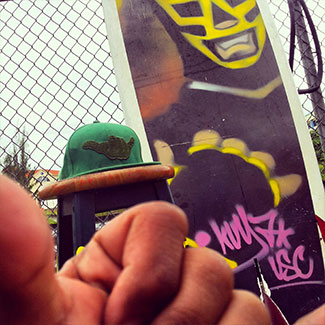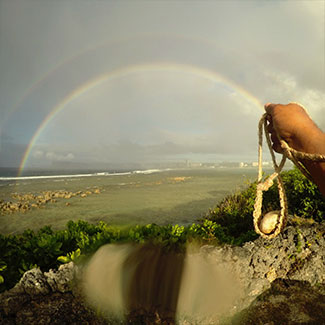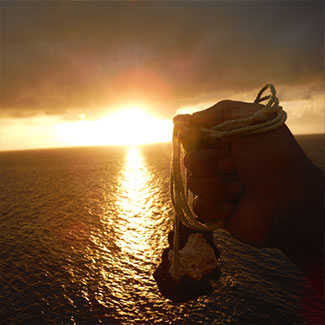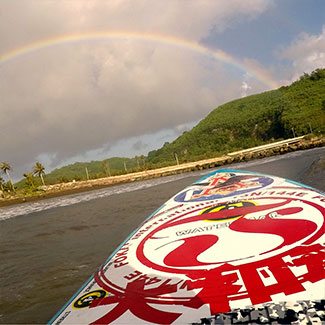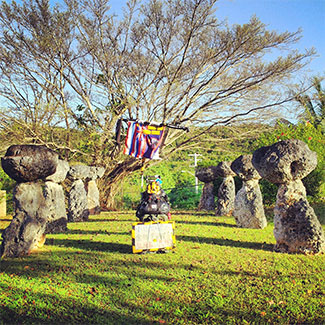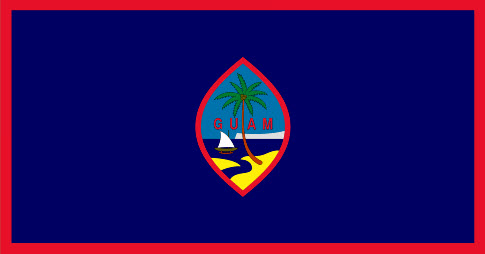CHAMORRO….THE ENGLISH WAY
October 25, 2020 by admin
Filed under Special Forces
Original Article from Pale Eric
CHAMORRO….THE ENGLISH WAY
Take, for example, the word saina. It’s Chamorro for anyone who is senior or higher in status than you. It could be a parent, older relative, older people in general and people of civic and religious standing. It can even be applied to God. Yet, a twenty-year-old is still saina to his or her five-year-old nephew or niece. It is a very elastic word in our language, but the essential meaning is clear. The saina is above, I am below.
As we engage more with our elders, we hear people speaking publicly about their - sainas. “We welcome all our sainas to today’s event.”
It sounds very supportive of the Chamorro language revival, but the word sainas is subjecting a Chamorro word to English grammatical rules.
In Chamorro, we do not denote something in the plural by adding an -S at the end of the word.
The exception to this rule is with some Spanish loan words. I senadot. The senator. I senadores. The senators. Señot. Sir. Señores. Sirs.
1. Add the prefix MAN before the word
ETMÅNA (religious sister)
MAN ETMÅNA (religious sisters)
MÅ’GAS (the great, the superior, the powerful, etc)
MAN MÅ’GAS (the great ones, superior ones, powerful ones, etc)
2. Keep in mind that MAN can undergo a change if the following word begins with K, P, S, T or CH
MAN + K = MANG
Kilisyåno = Mangilisyåno (Christians)
Katoliko = Mangatoliko (Catholics)
MAN + P = MAM
Påle’ = Mamåle’ (priests)
Popble = Mamopble (the poor people)
MAN + S = MAÑ
Sottera = Mañottera (single women, teenage girls)
MAN + T = MAN
Tomtom = Manomtom (the wise people)
Tunas = Manunas (the righteous people)
MAN + CH = MAÑ
Che’lu = Mañe’lu (the siblings)
3. Be careful, though; there are often exceptions
Man + parientes remains manparientes (the relatives).
Man + sendålo remains mansendålo (the soldiers).
Man + chunge’ remains manchunge’ (the gray/white haired ones).
Sometimes, there is a change and sometimes there isn’t.
Some people say Mañamorro and others say Manchamorro.
4. Adding the prefix MAN is not the only way to make something plural. Often, one simply adds the word SIHA after the word. SIHA denotes plural.
I Tagålo siha. The Filipinos. No one says “I man Tagålo,” although that is still grammatically correct.
I chetda siha. The bananas. No one says, “I man chotda.”
I gima’ siha. The houses. No one says, “I man guma’.”
Sometimes, one can use MAN and still use SIHA. That makes it very clear the subject is plural.
I man sendålo siha. The soldiers.
I man gefsaga siha. The wealthy people.
So…
|
INSTEAD OF….
|
TRY…
|
|
SAINAS
|
MAÑAINA
|
|
MAN ÅMKOS
|
MAN ÅMKO’
|
|
PÅLES
|
MAMÅLE’
|
|
GUMAS (often heard nowadays for houses of dance groups)
|
GUMA’ SIHA
|
|
FAFANA’GUES (often heard now for “teacher” in lieu of maestro/maestra)
|
MAN FAFANA’GUE or
FAFANA’GUE SIHA
|
Saina: Elders
October 25, 2020 by admin
Filed under Special Forces
Elders, parents, ancestors
Parents and other elders are important in CHamoru family and culture. CHamorus gain respect and status as they age. Younger relatives and friends show deference and respect to elders by sniffing or kissing the right hand or a cheek while saying ‘ñora or ‘ñot (for señora or señot) when arriving and leaving, or as part of an event. This may elicit the elder’s praise or a blessing. To not do so is considered ill-mannered, though some today are embarrassed to perform it or expect it.
The word, saina or its plural form, mañaina may refer to one’s parents, to all elders or to CHamoru ancestors depending on the context. Mañaina value their independence and they are sources of support, guidance, protection and wisdom for their families. Parents’ reputations hinge on raising families that abide by CHamoru mores of respect, reciprocal responsibilities and obligations including the duty of caring for their parents.
September 11, 1671, 2,000 Warriors Surrounded Hagåtña to free Chief Hurao
September 17, 2020 by admin
Filed under Special Forces
Article by: Michael Lujan Bevacqua
September 11, 1671, 2,000 Warriors Surrounded Hagåtña to free Chief Hurao
Every September 11th since September 11, 2001 has a surreal quality to it. As if in a world where history repeats and meaning is always muddled, somehow the events of that day achieved a special, extra level of meaning for those that were alive and of age to experience it. At least this is what they say, and how true this seems depends a lot on your relationship to the US and what type of imaginary tissue connects you to it.
9/11 always means another set of memorial or retrospectives. These commemorative acts help us lock in a particular narrative for conceiving what happened that day, what it means, and whether or not we allow any understanding of events that helped led to that attack. At these memorials people recall where they were when they learned of the attacks and reminders of how scared they were, but how America rose again from those ashes.
22 Years for 2020
April 25, 2020 by admin
Filed under Special Forces
Although,Fokai first came into light (relatively) in 1991–it was a 7 year conversation that finally got us started. The Fokai OG logo, designed by Fokai co-founder John Calvo made its debut in commerce with Superbrawl 7 on April 25th–22years ago today.
John would go to compete in the main event against the at-the-tim-UFC CHAMPION Dan Severn. 150 toal Tshirts in black, navy blue, and heather grey were printed on Russel Athletic blanks just 2 days prior. distributed through friends during the weighins and press conference then sold under-the-radar out from roving backpacks during the event. Though Fokai was first (and strangely for some still is) misuderstood as a Fight Club.
Despite the negativities associated with misunderstood fighting sport, Guam as a whole seemed to embrace Fokai as their representative in No Holds Barred Fighting.
Though we prayed to reach stars that are still far away.–we never could iamgine the adventures that would aim and are still aiming to lead us there.
All-terrain.Rocky Roads. Hills and Valleys.Scenic Routes.
Sacrifice.Hard work. Service.
Perseverance. Family Values.Resolution. Brotherhood.
Respect. Loyalty. Honor.
Fokai COVIT 19: World Vibration by Enson Inoue
April 7, 2020 by admin
Filed under Special Forces
via Enson Inoue I got this idea from my racquetball friend Sudsy. He did something like this with racquetball players all over the world to band together and stay positive to get through this Pandemic.
As fighters we always believe in ourselves that we can overcome any obstacles to defeat our opponent no matter who it is. We fighters are banding together to create a positive movement to knockout this invisible opponent Covid-19.
I have collaborated over 100 fighters from around the world so enjoy.
Wash your hands, practice social distancing, stay positive and knock out Covid-19.
Thank you all who sent in their videos! We are one and we will prevail.
Fokai Shops Closed Indefitely: Online Store OPEN
March 23, 2020 by admin
Filed under Special Forces
we are always looking out for your best. In light and reaction to thie recent pandemic Corona Virus–Our flagship stores will eb closed indefintiely
until were all back in the clear. We will be moving everything online in the meantime and will exercise this opportunity to evolve and upgrade our cyber services. Golly geez- things are really changing and it seems were on track towards a brand new world. Hopefully we will all find some light to brighten our way through this dark situation.
May hte Force bew tih us all.
JOE ROGAN AND THE FORCE
March 20, 2020 by admin
Filed under Special Forces
Some great words of advice from a very educated man who has seen alot, done alot, and works abundantly
to educate the world with excellent in depth conversations with some real earth-movers
Defend Yourselves: Wim Hof Basics
March 18, 2020 by admin
Filed under Special Forces
Wim Hof has found a clear path to ultimate self-improvement and hes happy to show us the way.
Arm yourselves and optimize your immune system with this PROVEN WEAPON of self-defense and life enhacnement!
THE FUTURE OF GUAM SLINGING: The Heritage Cup
March 18, 2020 by admin
Filed under Special Forces
ROCK ON.
Slinging Rocks: The Heritage Cup 2020
Slinging basics lesson and Some wordsin for the past, presnet, and future of Guam slinging and its conection to the 500th year anniversary commemoration of Pacific Islad mass contact with European Explorers

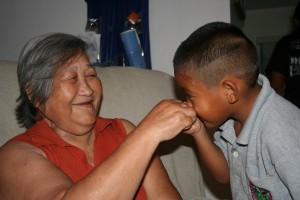
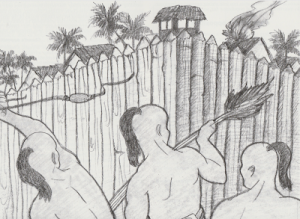
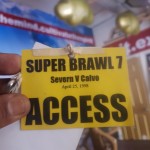
![CaptainFokai91] [Converted]](http://www.fokai.tv/fxv/wp-content/uploads/2020/03/CaptainFokai91-Converted-150x150.jpg)


